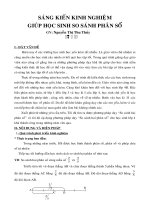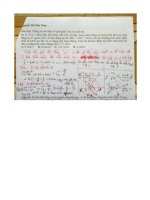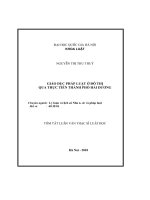NGUYEN THI THU THUY- thầy Toàn
Bạn đang xem bản rút gọn của tài liệu. Xem và tải ngay bản đầy đủ của tài liệu tại đây (181.9 KB, 11 trang )
Organization and distribution of Mitochondrion
Mitochondria are found in nearly all eukaryotes. They vary in number and location
according to cell type. A single highly branched mitochondrion was described in the
unicellular alga "Polytomella agilis".[18] Substantial numbers of mitochondria are in the
liver, with about 1000–2000 mitochondria per cell making up 1/5th of the cell volume.[6]
The mitochondria can be found nestled between myofibrils of muscle or wrapped around
the sperm flagellum.[6] Often they form a complex 3D branching network inside the cell
with the cytoskeleton. The association with the cytoskeleton determines mitochondrial
shape, which can affect the function as well.[19] Recent evidence suggests vimentin, one
of the components of the cytoskeleton, is critical to the association with the cytoskeleton.
[20]
Function
The most prominent roles of mitochondria are to produce ATP (i.e., phosphorylation of
ADP) through respiration, and to regulate cellular metabolism.[7] The central set of
reactions involved in ATP production are collectively known as the citric acid cycle, or
the Krebs Cycle. However, the mitochondrion has many other functions in addition to the
production of ATP.
Energy conversion
A dominant role for the mitochondria is the production of ATP, as reflected by the large
number of proteins in the inner membrane for this task. This is done by oxidizing the
major products of glucose, pyruvate, and NADH, which are produced in the cytosol.[7]
This process of cellular respiration, also known as aerobic respiration, is dependent on
the presence of oxygen. When oxygen is limited, the glycolytic products will be
metabolized by anaerobic respiration, a process that is independent of the mitochondria.[7]
The production of ATP from glucose has an approximately 13-fold higher yield during
aerobic respiration compared to anaerobic respiration.[21] Recently it has been shown that
plant mitochondria can produce a limited amount of ATP without oxygen by using the
alternate substrate nitrite.[22]
Pyruvate: the citric acid cycle
Each pyruvate molecule produced by glycolysis is actively transported across the inner
mitochondrial membrane, and into the matrix where it is oxidized and combined with
coenzyme A to form CO2, acetyl-CoA, and NADH.[7]
The acetyl-CoA is the primary substrate to enter the citric acid cycle, also known as the
tricarboxylic acid (TCA) cycle or Krebs cycle. The enzymes of the citric acid cycle are
located in the mitochondrial matrix, with the exception of succinate dehydrogenase,
which is bound to the inner mitochondrial membrane as part of Complex II.[23] The citric
acid cycle oxidizes the acetyl-CoA to carbon dioxide, and, in the process, produces
reduced cofactors (three molecules of NADH and one molecule of FADH2) that are a
source of electrons for the electron transport chain, and a molecule of GTP (that is
readily converted to an ATP).[7]
NADH and FADH2: the electron transport chain
The redox energy from NADH and FADH2 is transferred to oxygen (O2) in several steps
via the electron transport chain. These energy-rich molecules are produced within the
matrix via the citric acid cycle but are also produced in the cytoplasm by glycolysis.
Reducing equivalents from the cytoplasm can be imported via the malate-aspartate
shuttle system of antiporter proteins or feed into the electron transport chain using a
glycerol phosphate shuttle.[7] Protein complexes in the inner membrane (NADH
dehydrogenase, cytochrome c reductase, and cytochrome c oxidase) perform the transfer
and the incremental release of energy is used to pump protons (H+) into the
intermembrane space. This process is efficient, but a small percentage of electrons may
prematurely reduce oxygen, forming reactive oxygen species such as superoxide.[7] This
can cause oxidative stress in the mitochondria and may contribute to the decline in
mitochondrial function associated with the aging process.[24]
As the proton concentration increases in the intermembrane space, a strong
electrochemical gradient is established across the inner membrane. The protons can
return to the matrix through the ATP synthase complex, and their potential energy is used
to synthesize ATP from ADP and inorganic phosphate (Pi).[7] This process is called
chemiosmosis, and was first described by Peter Mitchell[25][26] who was awarded the 1978
Nobel Prize in Chemistry for his work. Later, part of the 1997 Nobel Prize in Chemistry
was awarded to Paul D. Boyer and John E. Walker for their clarification of the working
mechanism of ATP synthase.[27]
Heat production
Under certain conditions, protons can re-enter the mitochondrial matrix without
contributing to ATP synthesis. This process is known as proton leak or mitochondrial
uncoupling and is due to the facilitated diffusion of protons into the matrix. The process
results in the unharnessed potential energy of the proton electrochemical gradient being
released as heat.[7] The process is mediated by a proton channel called thermogenin, or
UCP1.[28] Thermogenin is a 33kDa protein first discovered in 1973.[29] Thermogenin is
primarily found in brown adipose tissue, or brown fat, and is responsible for nonshivering thermogenesis. Brown adipose tissue is found in mammals, and is at its highest
levels in early life and in hibernating animals. In humans, brown adipose tissue is present
at birth and decreases with age.[28]
Storage of calcium ions
The concentrations of free calcium in the cell can regulate an array of reactions and is
important for signal transduction in the cell. Mitochondria can transiently store calcium, a
contributing process for the cell's homeostasis of calcium.[30] In fact, their ability to
rapidly take in calcium for later release makes them very good "cytosolic buffers" for
calcium.[31][32][33] The endoplasmic reticulum (ER) is the most significant storage site of
calcium, and there is a significant interplay between the mitochondrion and ER with
regard to calcium.[34] The calcium is taken up into the matrix by a calcium uniporter on
the inner mitochondrial membrane.[35] It is primarily driven by the mitochondrial
membrane potential.[30] Release of this calcium back into the cell's interior can occur via a
sodium-calcium exchange protein or via "calcium-induced-calcium-release" pathways.[35]
This can initiate calcium spikes or calcium waves with large changes in the membrane
potential. These can activate a series of second messenger system proteins that can
coordinate processes such as neurotransmitter release in nerve cells and release of
hormones in endocrine cells.
Additional functions
Mitochondria play a central role in many other metabolic tasks, such as:
•
Regulation of the membrane potential[7]
•
Apoptosis-programmed cell death[36]
•
Calcium signaling (including calcium-evoked apoptosis)[37]
•
Cellular proliferation regulation[38]
•
Regulation of cellular metabolism[38]
•
Certain heme synthesis reactions[39] (see also: porphyrin)
•
Steroid synthesis.[31]
Some mitochondrial functions are performed only in specific types of cells. For example,
mitochondria in liver cells contain enzymes that allow them to detoxify ammonia, a waste
product of protein metabolism. A mutation in the genes regulating any of these functions
can result in mitochondrial diseases.
Electron transport chains in mitochondria
The cells of almost all eukaryotes contain intracellular organelles called mitochondria,
which produce ATP. Energy sources such as glucose are initially metabolized in the
cytoplasm. The products are imported into mitochondria. Mitochondria continue the
process of catabolism using metabolic pathways including the Krebs cycle, fatty acid
oxidation, and amino acid oxidation.
The end result of these pathways is the production of two kinds of energy-rich electron
donors, NADH and succinate. Electrons from these donors are passed through an electron
transport chain to oxygen, which is reduced to water. This is a multi-step redox process
that occurs on the mitochondrial inner membrane. The enzymes that catalyze these
reactions have the ability to simultaneously create a proton gradient across the
membrane, producing a thermodynamically unlikely high-energy state with the potential
to do work. Although electron transport occurs with great efficiency, a small percentage
of electrons are prematurely leaked to oxygen, resulting in the formation of the toxic freeradical superoxide.
The similarity between intracellular mitochondria and free-living bacteria is striking. The
known structural, functional, and DNA similarities between mitochondria and bacteria
provide strong evidence that mitochondria evolved from intracellular bacterial symbionts
(see Endosymbiotic theory).
Mitochondrial redox carriers
Stylized representation of the ETC. Energy obtained through the transfer of electrons
(black arrows) down the ETC is used to pump protons (red arrows) from the
mitochondrial matrix into the intermembrane space, creating an electrochemical proton
gradient across the mitochondrial inner membrane (IMM) called ΔΨ. This
electrochemical proton gradient allows ATP synthase (ATP-ase) to use the flow of H+
through the enzyme back into the matrix to generate ATP from adenosine diphosphate
(ADP) and inorganic phosphate. Complex I (NADH coenzyme Q reductase; labeled I)
accepts electrons from the Krebs cycle electron carrier nicotinamide adenine dinucleotide
(NADH), and passes them to coenzyme Q (ubiquinone; labeled UQ), which also receives
electrons from complex II (succinate dehydrogenase; labeled II). UQ passes electrons to
complex III (cytochrome bc1 complex; labeled III), which passes them to cytochrome c
(cyt c). Cyt c passes electrons to Complex IV (cytochrome c oxidase; labeled IV), which
uses the electrons and hydrogen ions to reduce molecular oxygen to water.
Four membrane-bound complexes have been identified in mitochondria. Each is an
extremely complex transmembrane structure that is embedded in the inner membrane.
Three of them are proton pumps. The structures are electrically connected by lipidsoluble electron carriers and water-soluble electron carriers. The overall electron
transport chain
NADH → Complex I → Q → Complex III → cytochrome c → Complex
IV
→ O2
↑
Complex II
Complex I
Complex I (NADH dehydrogenase, also called NADH:ubiquinone oxidoreductase; EC
1.6.5.3) removes two electrons from NADH and transfers them to a lipid-soluble carrier,
ubiquinone (Q). The reduced product, ubiquinol (QH2) is free to diffuse within the
membrane. At the same time, Complex I moves four protons (H+) across the membrane,
producing a proton gradient. Complex I is one of the main sites at which premature
electron leakage to oxygen occurs, thus being one of main sites of production of a
harmful free radical called superoxide.
The pathway of electrons occurs as follows:
NADH is oxidized to NAD+, reducing Flavin mononucleotide to FMNH2 in one twoelectron step. The next electron carrier is a Fe-S cluster, which can only accept one
electron at a time to reduce the ferric ion into a ferrous ion. In a convenient manner,
FMNH2 can be oxidized in only two one-electron steps, through a semiquinone
intermediate. The electron thus travels from the FMNH2 to the Fe-S cluster, then from the
Fe-S cluster to the oxidized Q to give the free-radical (semiquinone) form of Q. This
happens again to reduce the semiquinone form to the ubiquinol form, QH2. During this
process, four protons are translocated across the inner mitochondrial membrane, from the
matrix to the intermembrane space. This creates a proton gradient that will be later used
to generate ATP through oxidative phosphorylation.
Complex II
Complex II (succinate dehydrogenase; EC 1.3.5.1) is not a proton pump. It serves to
funnel additional electrons into the quinone pool (Q) by removing electrons from
succinate and transferring them (via FAD) to Q. Complex II consists of four protein
subunits: SDHA,SDHB,SDHC, and SDHD. Other electron donors (e.g., fatty acids and
glycerol 3-phosphate) also funnel electrons into Q (via FAD), again without producing a
proton gradient.
Complex III
Complex III (cytochrome bc1 complex; EC 1.10.2.2) removes in a stepwise fashion two
electrons from QH2 at the QO site and sequentially transfers them to two molecules of
cytochrome c, a water-soluble electron carrier located within the intermembrane space.
The two other electrons are sequentially passed across the protein to the Qi site where
quinone part of ubiquinone is reduced to quinol. A proton gradient is formed because it
takes 2 quinol (4H+4e-) oxidations at the Qo site to form one quinol (2H+2e-) at the Qi
site. (in total 6 protons: 2 protons reduce quinone to quinol and 4 protons are released
from 2 ubiquinol). The bc1 complex does NOT 'pump' protons, it helps build the proton
gradient by an asymmetric absorption/release of protons.
When electron transfer is reduced (by a high membrane potential, point mutations or
respiratory inhibitors such as antimycin A), Complex III may leak electrons to molecular
oxygen, resulting in the formation of superoxide, a highly-toxic reactive oxygen species,
which is thought to contribute to the pathology of a number of diseases and to processes
involved in aging.[citation needed]
Complex IV
Complex IV (cytochrome c oxidase; EC 1.9.3.1) removes four electrons from four
molecules of cytochrome c and transfers them to molecular oxygen (O2), producing two
molecules of water (H2O). At the same time, it moves four protons across the membrane,
producing a proton gradient. In cyanide poisoning, this enzyme is inhibited.
Coupling with oxidative phosphorylation
The chemiosmotic coupling hypothesis, as proposed by Nobel Prize in Chemistry winner
Peter D. Mitchell, explains that the electron transport chain and oxidative
phosphorylation are coupled by a proton gradient across the inner mitochondrial
membrane. The efflux of protons creates both a pH gradient and an electrochemical
gradient. This proton gradient is used by the FOF1 ATP synthase complex to make ATP
via oxidative phosphorylation. ATP synthase is sometimes regarded as complex V of the
electron transport chain. The FO component of ATP synthase acts as an ion channel for
return of protons back to mitochondrial matrix. During their return, the free energy
produced during the generation of the oxidized forms of the electron carriers (NAD+ and
Q) is released. This energy is used to drive ATP synthesis, catalyzed by the F 1 component
of the complex.
Coupling with oxidative phosphorylation is a key step for ATP production. However, in
certain cases, uncoupling may be biologically useful. The inner mitochondrial membrane
of brown adipose tissue contains a large amount of thermogenin (an uncoupling protein),
which acts as uncoupler by forming an alternative pathway for the flow of protons back
to matrix. This results in consumption of energy in thermogenesis rather than ATP
production. This may be useful in cases when heat production is required, for example in
colds or during arise of hibernating animals. Synthetic uncouplers (e.g., 2,4dinitrophenol) also exist, and, at high doses, are lethal.









